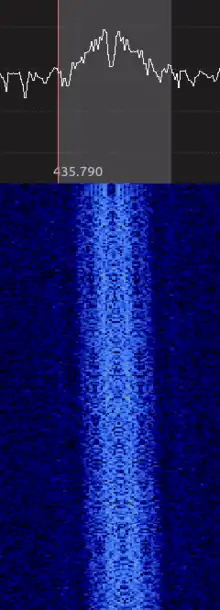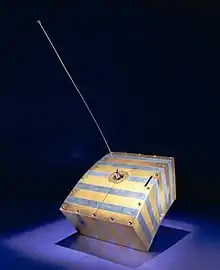.jpg.webp)
HuskySat-1 is an artificial satellite designed at the University of Washington. It was launched by Cygnus NG-12 from Mid-Atlantic Regional Spaceport Launch Pad 0 on Wallops Island, Virginia to low earth orbit on November 2, 2019. It is a CubeSat, and will demonstrate onboard plasma propulsion and high gain telemetry for low Earth orbit that would be a precursor for an attempt at a larger CubeSat designed for orbital insertion at the Moon.[1]
The satellite was designed by Husky Satellite Lab, a registered student group, in Johnson Hall, and was controlled from there using three antennae installed on the roof.[2][3]
A pulsed plasma thruster (PPT) provides propulsion.[4] It is the first PPT to use sulfur as a fuel.[2]
Students at Raisbeck Aviation High School designed an onboard camera.[5][4]
The satellite will test an experimental 24 GHz data transmitter, after which it will become an amateur radio satellite operated by AMSAT.[6] The high data rate will enable much more data to be transferred during the 9- to 15-minute time windows the satellite is visible from the control station.[2]
HuskySat is the first satellite designed by students in Washington state.[5]
The satellite decayed from orbit on 12 April 2023.[7]

References
- ↑ Shanessa Jackson (February 17, 2017). "NASA Announces Eighth Class of Candidates for Launch of CubeSat Space Missions". NASA TV.
- 1 2 3 Matthew Hipolito (November 1, 2019). "UW blasts into space: Washington's first student-built satellite to be launched this Saturday". The Daily of the University of Washington.
- ↑ Hannah Hickey (October 31, 2019). "Washington's first student-built satellite preparing for launch". UW News. University of Washington.
- 1 2 Boyle, Alan (November 2, 2019). "Cygnus cargo ship heads to space station with satellite built by students in Seattle". GeekWire.
- 1 2 Oxley, Dyer (October 31, 2019). "Washington students to make satellite history with HuskySat-1". KOMO News.
- ↑ "HuskySat-1 Successfully Lifted into Space". American Radio Relay League (ARRL). November 4, 2019.
- ↑ "HUSKYSAT-1". N2YO.com. 12 Apr 2023. Retrieved 19 Aug 2023.
External links
![]() This article incorporates public domain material from NASA Announces Eighth Class of Candidates for Launch of CubeSat Space Missions. NASA. Retrieved 2019-11-04.
This article incorporates public domain material from NASA Announces Eighth Class of Candidates for Launch of CubeSat Space Missions. NASA. Retrieved 2019-11-04.
